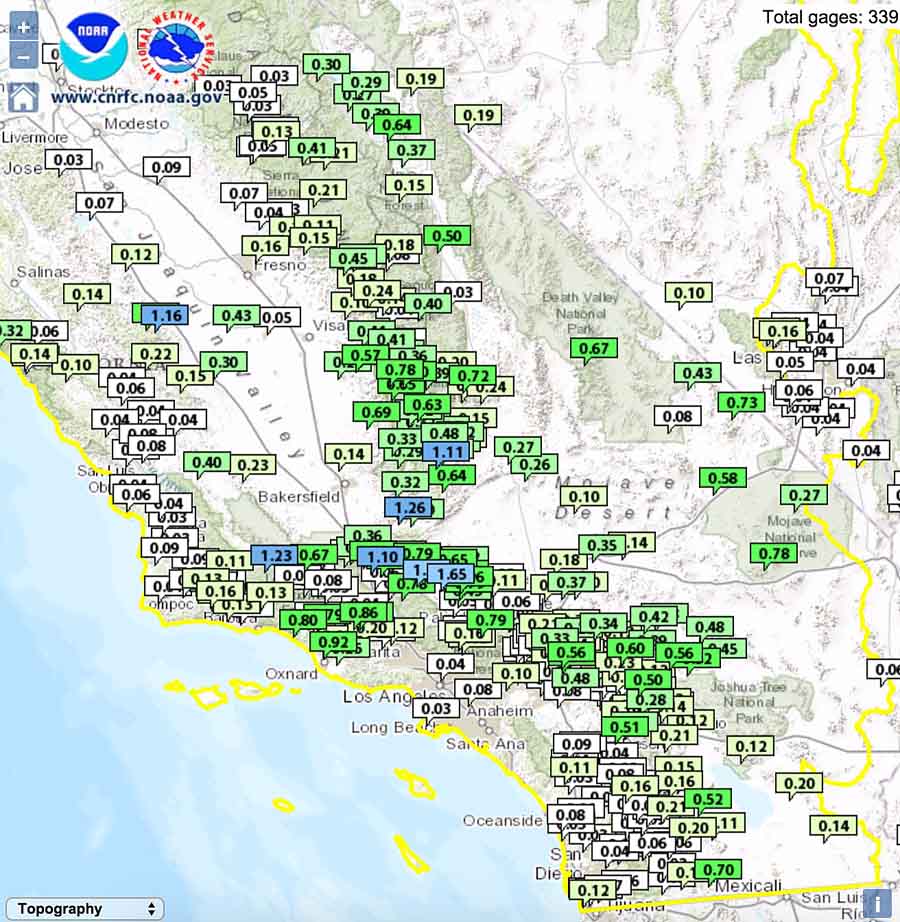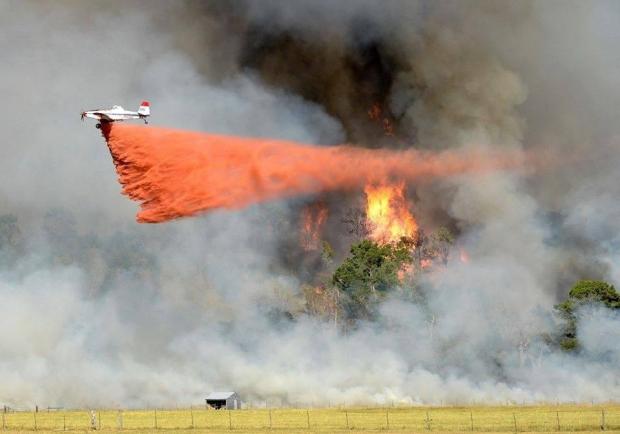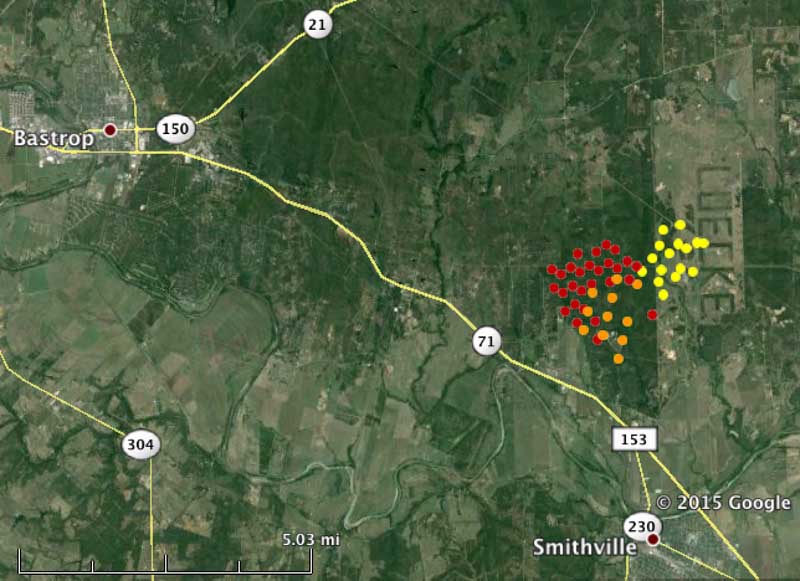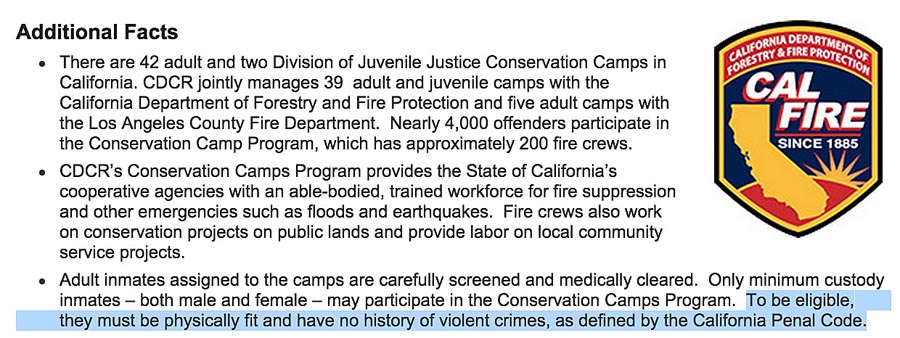This video, an introduction to the Logistics Section on the Canyon Creek Fire, was uploaded to YouTube by Karen Roganov September 5, 2015. This complex of fires burned over 110,000 acres in eastern Oregon this summer.
Category: Uncategorized
Rain slows wildfire season in southern California

Massive amounts of rain in scattered locations and a general rain over much of the area over the past five days could pause the wildfire season in southern California.

Over an inch and a half of rain fell north of Los Angeles causing mud slides that closed 20 miles of Interstate 5 in the Tejon Pass/Grapevine area on Thursday and Friday. Over 200 vehicles on the highway were entrapped by the flowing debris. Some drivers sought refuge on the top of their cars, while in another area residents were rescued from the roofs of their houses.

The Los Angeles office of the National Weather Service warns that more flash flooding is possible in southern California today, Friday.
The multi-year drought and warnings of an above normal fall fire season in southern California in October had many fire officials on edge, and prompted the Los Angeles County Fire Department to double the number of scooping air tankers on contract from two to four.
The Wildland Fire Potential Outlook issued October 1 by the Predictive Services section at the National Interagency Fire Center predicted enhanced fire potential for southern California in October with “little if any precipitation”. Below is an excerpt:
Southern California: Above normal significant wildland fire potential will continue for the mountains and coastal areas of southern California in October, with the conditions trending toward normal in central California by the end of the month. Above normal fire potential will continue for the southern coastal areas into November before returning to normal by December.
Southern and central California will be dominated by high pressure during the first half of October, resulting in warm, to occasionally hot conditions throughout the region with periods of light to moderate offshore flow. Little if any precipitation is anticipated. There may be a trend towards cooler weather during the latter part of the month, but with the anticipated weather pattern, most of October will likely experience precipitation deficits.
The map below shows cumulative precipitation for the contiguous United States during the last seven days.

Confusion about responsibility for suppression of wildfires?
In an article that is very timely, with another disastrous fire burning homes in Bastrop County Texas this week, Donald F. Kettl published an article in Governing exploring what he calls “confusion” about who is responsible for fighting some of the largest and most damaging wildfires. Below is an excerpt:
…Local residents increasingly expect a response that is federal and instant.
Nowhere was this more the case than during the 2011 Texas wildfires, which burned more than 3 million acres and devastated Bastrop County, near Austin. Texas Rep. Michael McCaul, who represents the area, hammered the U.S. Forest Service for failing to pre-position a giant DC-10 aerial tanker that the state could use whenever a wildfire should happen to erupt. When the Bastrop fire started, the Forest Service’s contractor fleet was busy in California, fighting an outbreak of wildfires there. The Forest Service shifted a DC-10 to Texas, but residents were infuriated as the plane sat idle for two days on a runway while Bastrop burned.
Why was the plane idle? The DC-10’s crew had to adhere to mandatory rest requirements. Furthermore, ground crews had to build a facility to supply flame retardant for the plane. But all that missed a larger issue, according to Tom Harbour, the Forest Service’s director of fire and aviation. At an oversight hearing that McCaul held in Austin after the disaster, Harbour pointed out that the Forest Service was only responsible for fighting the fires on its lands, which accounted for just 0.1 percent of all the land involved in the 2011 Texas fires. The agency had deployed its teams to help on nonfederal lands “because our friends in the Texas Forest Service asked us to help.” And they needed that help because Gov. Rick Perry had cut funding for the state’s own forest service.
But truthfully, the feds would have been in Texas no matter what. After all, firefighting has become an interagency, intergovernmental affair.
And there’s no doubt these interagency partnerships have vastly improved firefighting, but they have also blurred responsibilities, raised expectations for the federal government’s help and shifted local costs to the federal budget, even when the problems are caused by nature and the prime responsibility for attacking them rests in state and local hands. The strategy that so greatly improved the management of fires has, paradoxically, deeply confused who’s really responsible for dealing with and paying for a huge problem that is only growing.
Former Board members criticize Wildland Firefighter Foundation
 The Wildland Firefighter Foundation is in the news again for issues between the staff and the Board of Directors. Below is an excerpt from an article by Rocky Barker in the Idaho Statesman:
The Wildland Firefighter Foundation is in the news again for issues between the staff and the Board of Directors. Below is an excerpt from an article by Rocky Barker in the Idaho Statesman:
Three board members left the Wildland Firefighter Foundation earlier this month saying the charity hasn’t made the changes necessary after a controversy over the leadership of its founder and director Vicki Minor.
Cheryl Molis, a retired Forest Service administrative manager and treasurer of the group from Boise, Dan Friend, former Eagle Fire Chief and Boise attorney Steve Smith stepped down after Minor, who is beloved in the wildland firefighting community for her aid to the families of killed and injured firefighters, elevated her assistant to chief financial officer.
The three raised questions about her qualifications and independence from Minor and her son Burk who run the group that raises $2 million and distributes $400,000 to the families of down firefighters.
“They want to run it like a family business, not a non-profit,” said Molis.
Minor praised all three and said they had timed out on the board. Minor took issue with Molis…
Similar issues have been going on since at least April, 2015.
Fire in Bastrop County, Texas burns nine homes
(UPDATE at 9:05 p.m. CT, October 16, 2015)
Bastrop County has updated the number of structures that burned in the Hidden Pines Fire north of Smithville, Texas. They are reporting that 48 homes burned along with 70 outbuildings. In addition, 69 vehicles and 16 RVs burned.
****
(UPDATED at 1:13 a.m. CT, October 16, 2015)

Recent mapping of the Hidden Pines Fire north of Smithville, Texas shows that it grew about 200 acres over the last 24 hours to 4,582, according to the Bastrop County Office of Emergency Management. Today they are saying “approximately 40 structures” burned, but did not specify how many of those were residences. On Thursday local fire officials reported that nine homes had burned. The Southern Area Coordination Center’s Morning Report on Friday, October 16 said nine residences have burned.
The Statesman, based in Austin, Texas, reported that a DC-10 Very Large Air Tanker will be available for the fire Friday, but it will have to reload with fire retardant in Chattanooga, Tennessee, about 770 miles away. The DC-10 carries 11,600 gallons of retardant, compared to the single engine air tankers that have been working the fire with less than 1,000 gallons.
Texas politicians complained vigorously in 2011 during another fire siege in Bastrop County when they could not immediately obtain the services of a DC-10 that was on contract to the U.S. Forest Service. The aircraft flew to Texas, but had to sit for two days while the flight crew took mandatory days off and a portable fire retardant plant was assembled. Now four years later the state still does not have retardant facilities at an airport that can reload the huge airplane.
In Texas the local county judges are responsible for suppression of wildland fires. (This reminds of the systems in Colorado and Wyoming where the local county sheriffs have that responsibility, rather than fire personnel.) Bastrop County Judge Paul Pape told reporters that it is possible, but not yet confirmed, that the Hidden Pines Fire started when a rancher was pulling a shredder through grass and an overheated bearing on the device ignited grass clippings.
****
(Originally published at 11:51 CT, October 15, 2015; updated at 5:47 p.m. CT, October 15, 2015)
After an 11:30 a.m. mapping flight, fire officials report that the Hidden Pines Fire north of Smithville, Texas has burned 4,383 acres. According to the Bastrop County Sheriff’s Office approximately 400 homes are affected by the evacuations.
Creations by Cynthia has numerous aerial photos of the fire.
****

A wildfire in Bastrop County, Texas has burned nine homes and about 4,200 acres. The Hidden Valley Fire started on October 13 north of Smithville, and 29 miles southeast of Austin. Several areas are under evacuation orders.
Governor Greg Abbott declared a state of disaster in Bastrop County and the state has mobilized Blackhawk and Chinook National Guard helicopters. The Southern Area’s Blue incident management team is being mobilized for the fire. Below is a recording sent Thursday morning which informs team members of the assignment.
The Governor requested a fire management assistance grant from the Federal Emergency Management Agency, which was approved immediately. The FEMA grant will pay for up to 75 percent of the costs for fighting the fire.
As you can see in the satellite photo above the fire is burning near some letters, “LUECKE”, that can be seen from space. The landowners name was was left after a clear cutting operation which opened the area for grazing. It is common to leave some areas untouched to benefit wildlife after clear cutting, but using surveyors to lay out those places in the form of huge letters is, of course, unusual. Astronauts on the International Space Station use “LUECKE”, which is 2.5 miles long, to evaluate the resolution of their cameras.
The weather forecast for Thursday and Friday calls for temperatures in the low 90s, minimum humidities in the low 20s, and 3 to 8 mph winds.
A RAWS weather station is located 11 miles northeast of the fire.
California officials admit they misled the public about violent inmates working on fire crews
 In a stunning admission Wednesday, the California Department of Corrections admitted that they misled the public for years when they said violent offenders in prison were not allowed to work on inmate wildland firefighting crews.
In a stunning admission Wednesday, the California Department of Corrections admitted that they misled the public for years when they said violent offenders in prison were not allowed to work on inmate wildland firefighting crews.
After the Associated Press ran a story on October 12 saying the CDC was considering allowing inmates to serve on fire crews even if they were convicted of violent offenses such as assaults and robberies, there was considerable criticism. Later in the day, according to the Washington Post, the proposal was scrapped while it was still in a final review stage.
On Wednesday, October 14, the Associated Press published a followup story revealing that the CDC had been allowing violent offenders to work on fire crews since at least the 1990s. According to the AP, corrections officials revealed that about 1,400 of the state’s 3,700 inmate firefighters have previous convictions for violent offenses.
Department of Corrections and Rehabilitation spokesman Jeffrey Callison said a statement on the department’s website that participating inmates must have no history of violent crimes under California’s penal code “was a thoroughly misleading statement.”
That statement has now been scrubbed from the CDC’s website, but thanks to the Way Back Machine we were able to find a version of the page saved on September 5, 2015:

California inmate fire crews are supervised on the fireline by CAL FIRE Captains, but corrections officials maintain contact with them at the incident base.
I worked as a federal firefighter in California throughout the 1970s and 1980s, and frequently worked, if not alongside, near inmates. They were just a fact of life. I was under the impression then that they had not been convicted of violent crimes. But if I were there now, knowing that about 38 percent of them are violent offenders, I would have a different opinion about working with them, eating with them, and sleeping on the ground in the same camp with them. And I can’t even imagine what a female firefighter in California must be thinking about now, after the state admitted they have been lying for years about the composition of their crews.
Thanks and a tip of the hat go out to Dick.
